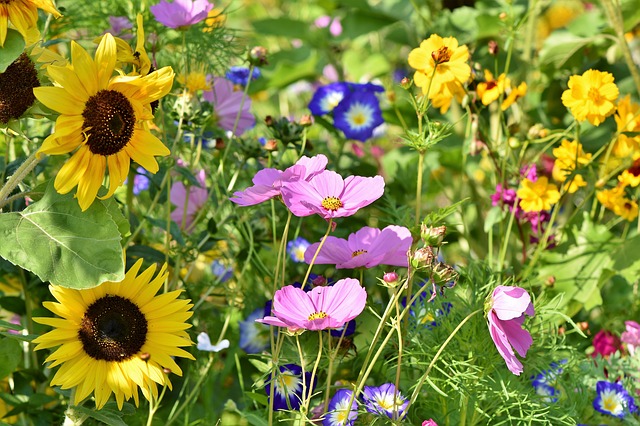
Wildflower Garden Ideas
At this time of year, pathways, hedgerows, woodlands and verges are full of colour from wildflowers which give us plenty of inspiration for wild flower garden ideas.
Their nectar rich blooms open with the aid of Nature’s perfect timing to coincide with hungry bees and pollinators who are waking up and needing to find food.
And Who doesn’t love a wildflower meadow or a swathe of wild colour by the roadside?
Or a ripe cornfield dotted with scarlet poppies?
Who recalls, as a child making daisy chains or holding a buttercup under their chin to test whether they like butter?
Or told the time by blowing away the seeds of a Dandelion clock?
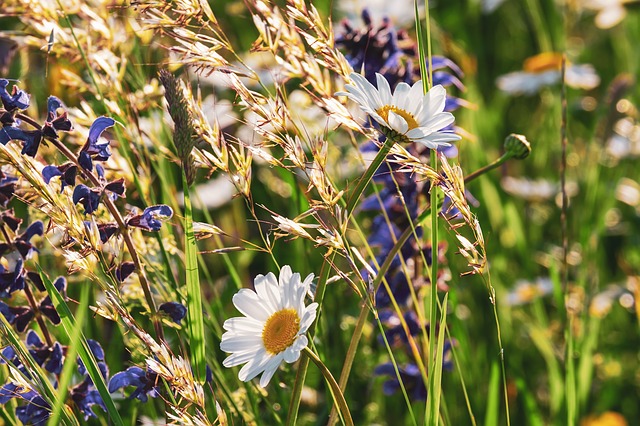
Why Do We Need Wildflowers?
After decades of intensive farming, road building and property development, we are rapidly losing some of our treasured wildflowers.
Without them the fragile eco system starts to collapse.
Bees, butterflies and many other insects, birds and animals rely on wildflowers for habitat, shelter and food.
Wildflowers are tough and resilient, after all they go through, they need to be.
Deserts that have been dry for years will suddenly burst into myriad colours after rainfall. Flower seeds that have lain dormant flourish within a short window of time… setting seed to wait for the next downpour.
Seeing a barren landscape come into bloom is a sight for sore eyes.
Wildflowers will pretty much sow themselves anywhere.
Dandelions will pop up in concrete and tarmac. Daisies thrive in stone walls or cobbled paths.
Red Campion and Ragged Robin will also put down roots in what seem to us the most inhospitable environments.
Ox-eye daisies thrive and multiply everywhere, whatever the conditions.
Gladioli italicus grows on wasteland, as will lupine. Summer Flowering Bulbs A colourful addition to summer gardens.
In the rush to find new and exotic plants from around the world, the humble wildflowers were, sadly, destined to take a backseat.
Botanists and plant breeders were keen to create new flowers. All the flowers and plants that we love to grow in our gardens have been bred from wild flowers. They all trace their roots back to native, indigenous species. However, the original plant is the one proves most resistant to pests and diseases; they have, after all, had millions of years to evolve and strengthen their defences. New plants are inter-bred, changed and modified in order to produce something deemed “perfect”, but in doing so we have also bred weakness into them. This is why pests and diseases have become more widespread as plants are far more susceptible to them and unable to fight them off.
Since the 1930’s the UK has lost 99% of unimproved grasslands.
Wildflowers came to be looked upon by gardeners as weeds, unwanted and undesirable.
But were it not for them we wouldn’t have the huge array of plants that are available today.
One of my favourite sayings is –
“A weed is just a plant in the wrong place.”
Wildflower Garden Ideas
Gardeners, plant specialists and environmentalists have realised just how important wildflowers are for the survival of our eco systems.
Gardeners are now turning their minds to planting more wildflowers. The regeneration of these lovely, indigenous plants can only have a lasting benefit for the insects, pollinators, birds and animals who thrive amongst them.
Anyone can grow them, they germinate easily and there is very little maintenance involved. There is however some preparation to do of the area you wish to turn into a wildflower garden. Easy Low Maintenance Garden Ideas
If you wish to turn your manicured lawn into a meadow or beds and borders into havens for wildlife then read on to see how to Plant a Wildflower Garden.
How to Plant a Wildflower Garden

Preparing the Site
Choose a suitable site, somewhere open and sunny. The larger the better if you’re going for the full on meadow look.
Flat or sloped ground is fine.
A small area is OK too, you don’t necessarily have to have a huge area available. Any wild flower bed will become a magnet for our wildlife.
Once you have decided on an area for your wild garden it needs some preparation before planting.
Remove any weeds such as ground elder, nettles, bindweed or any others that you don’t want. This can take some time to fully eradicate them, but it’s a job that can be done at any time of year.
If you are turning your lawn or part of it into a wildflower garden then first remove the turf.
Garden soil usually has had lots of organic material such as leaf mulch, compost and soil improvers added to it over years. These are required for a conventional flower garden, but it will prove to be too rich and nutritious for wild flowers.
Reducing the fertility of the soil means removing three to six inches of topsoil. This too will take some time depending on the size of your wildflower garden.
Alternatively sow some hungry plants such as brassicas for a season.
Dig the soil, and rake to a fine tilth. Cover the area with weed suppression fabric or black plastic and leave it until autumn.
Planting
Seed planting is best done in autumn when the soil is warm.
You need approximately 5grams of seeds per square metre. Walk across the site scattering the seeds as you go. Aim for an even spread.
Water gently and leave the rest to nature.
Wildflower Seed Mixes
A good mix of seeds will give you lots of different wildflowers. Generally a mix will include natural, indigenous flower species and grasses. You can buy packets of ready mixed seed varieties. This tends to work out cheaper than buying packets of individual seeds.
Click here for a great choice of Wild Flower Seeds
What Are The Best Wildflowers To Plant?
Luckily wildflowers are making a come back. They have been waiting in the wings a long time… I did mention that they are resilient.
There are so many flowers that you can include in your wildflower planting schemes, it really is your own preference and what you want to achieve. Bees, butterflies and lots of other useful insects are attracted to many different flowers. You can buy seed mixes that will include them. The time of year that you want flowers will also determine what you choose to plant. Grasses are also available to plant. The area, soil type, shaded areas, full sun etc will also be deciding factors on which wildflowers will perform well.
Good mixes include:
- birds-foot trefoil (good for common blue butterfly caterpillars)
- common sorrel (good for small copper butterfly caterpillars)
- cornflower
- forget-me-nots
- red campion
- foxgloves
- buttercup
- cowslip
- field scabious
- hoary plantain
- greater and common knapweed
- lady’s bedstraw
- corn-cockle
- ox-eye daisy
- red clover
- ribwort plantain
- wild carrot
- yellow rattle, this is a must have ingredient to help reduce the vigorous growth of grasses.
- wild grasses, such as bents, fescues and crested dogstail
Wildflowers for Shade
As with any plant there are varieties that do better in shady areas, out of the full heat of the sun.
- red campion
- white campion
- common StJohns wort
- wild garlic
- common knapweed
- teasels
- cowslip
- foxglove
- wild angelica
- tufted vetch
- common bent
Wildflowers for Clay Soil
Plants that Grow Well in Clay Soil
- lady’s bedstraw
- birds-foot trefoil
- buttercup
- salad burnet
- clowslips
- ox-eye daisy
- selfheal
- yarrow
- yellow rattle
- field scabious
- ragged robin
- red campion
How to Maintain a Wildflower Garden
Wildflower meadows need a yearly mowing and possibly some weeding in order to maintain a good, healthy mix of plants.
New Gardens and Meadows
New gardens and meadows need to be mowed/cutback in the first year of planting to encourage strong root growth of perennials and grasses.
Cut after the first six to eight weeks of growing to about two inches. Repeat every two months through the summer months.
Some people like to mow a path through, this is more aesthetically pleasing I think if the path meanders and looks natural rather than straight paths.
So, other than mowing a few paths and a few cuts per season you can effectively put the lawn mower away.
Ryobi OLM1833H ONE+ Lawn Mower, 18 V Review
After the flowering season of all annuals when the plants have dropped their seed is the time to mow or strim the garden or meadow. This ensures that seed is already in the soil ready to germinate for next year.
Established Gardens and Meadows
The mowing or cutting of established gardens really depends on which plants are to be encouraged and the vigour of growth. Mow once or twice per season. Leave the clippings for a day or two so that the seeds can be left ready to germinate the following year.
Spring
Cut no later than April. Cut to about three inches height. The spring mow is effective in slowing down the lush growth of grasses, and favours the spring flowers such as fritilaria, cowslips and selfheal.
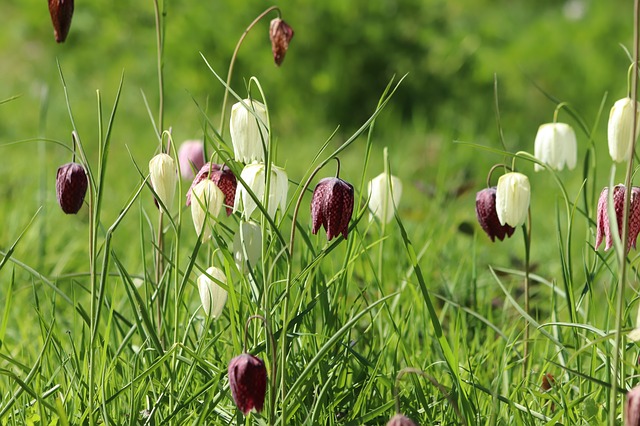
Summer
Cut between late June and end of August. This removes the bulk of the summers’ growth and it can be composted.
The cut at this time of year benefits the summer plants such as knapweed, scabious and lady’s bedstraw.
Autumn
Two cuts between the end of August and the end of November removes any surplus growth and helps to maintain the dominance of flowers in preference to grasses. If necessary sow more yellow rattle in autumn to control the vigorous growth of grasses.
Winter
Meadows can be mowed a couple of times through winter if desired in order to keep them looking tidy and to keep the grass short.
Clippings should be removed and composted.
Meadows or wildflower gardens do not need watering or feeding.
Many of our native plants have always colonised and thrived on poor soils, hence why they were considered weeds in the first place.
Funny how everything has its day. Luckily for our native wildflower species those days are coming around again. We need to help them survive. Without them the countryside will suffer as will the bees, butterflies, birds and other wildlife.
For wild flower gardens to visit near you… https://www.greatbritishgardens.co.uk/wildflowers.html
Please plant some wildflowers in your gardens this year. A small patch will help. Allow some to move into the flower beds, they look just as pretty if not prettier than our usual herbaceous plants. I have many self seeded plants in my borders. But then I much prefer the daisies to the debutantes.
I hope this article has helped you in terms of giving you some food for thought for wild flower garden ideas and shown you just how easy it is to nurture wildflowers and how to incorporate a wild flower space into your gardens. If you have the land then please do go ahead and grow a meadow. I guarantee you will get a real good feeling from doing so. Gardening for Well-being, Why Gardening is Good for your Health.
Please share this article with friends, family, and social media. if you have found it useful and interesting. I love to hear your thoughts and ideas so please leave any comments below, I always reply as soon as I can.
Happy Gardening!

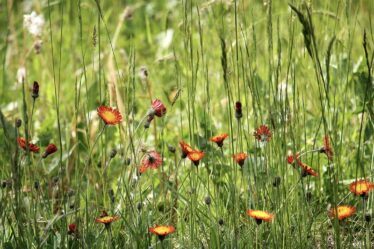
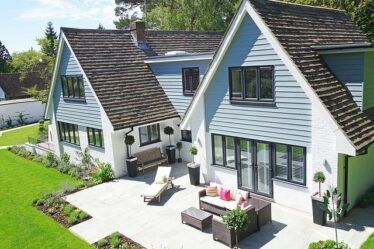


Planting trees is essential for our environment. Wildflower garden is a great idea indeed which is beautifully depicted in the article. I have a dream of making a house surrounding with lots of trees. When I have my own house I will keep space on the premises so that I can plant different types of trees there. Thanks for sharing your idea.
Hello Fahim,
thank you for your comments,
Yes trees are important but we are risking losing our wild flowers and if that happens then we lose a lot of beneficial insects and other wildlife so I do hope you have some wildflowers when you get your own space to garden in.
Best Wishes
An interesting and engaging post you have here. As much as I love gardening and how beautiful plants and flowers could look, I have never thought of gardening wild flowers. Going by the images I saw, they look very pretty and beautiful to behold. Very nice tips you have given on how to nurture them and I think its really worth given a try. Having a new look and feel would make a beautiful atmosphere.
Hello,
Thank you for taking the time to comment. Wildflowers look really lovely in any setting. They add something more natural to the feel of gardens. I have let parts of my garden go wild and they look very pretty. Wildflowers in amongst the cultured ones. It isn’t necessary to have completely wild flowers everywhere… just some would be a benefit to our wildlife. So I do hope you decide to allow some into your garden too.
All the Best
Louise
I want to first say Thank You! Your pointers on Wildflowers for shade and clay, have given me inspiration for my garden ideas!
I’m not a gardener type, but I love wildflowers! They remind me of my childhood and roaming the pastures… trying to catch that silly horse of mine! (Resilence for me is necessary! I can kill a silk plant)!
So often seen as a ‘weed’ (love your quote by the way… ‘a weed is just a plant in the wrong place’), we have forgotten the value of the wildflower. From the bees to fertilization of the soil naturally, the advantages are endless!
Because I live in Alberta, Canada, what would your suggestions be for seeds or mixes to maximize my efforts?
Thank You for the Idea!
Shaunna
Hello Shauna,
Thank you for your comments, I have visions of you now… running around after your horse! :))
It is important that we re-instate our wildflowers before they are lost forever.
In answer to your question about which flowers there are in Canada, most of them are pretty much the same as here in the UK. Buttercups, bird vetch, fairy bell, harebells, asters, goldenrod, hawkweed, oxeye are but a few.
All the Best
Louise
Great idea, wildflower garden! There really are some beautiful wildflowers out there, and the idea of gathering them into a more condensed garden sounds intriguing. I also like the idea of preserving them this way, and honestly I hadn’t thought of it before so this provides a nice perspective. Wildflowers also help to maintain the insect population, which most people (myself included) I would imagine tend to forget. Well done providing a thorough explanation on how to plant a wildflower garden. I will definitely be checking out your seed link further, thank you!
Hello,
Thank you very much for your comments.
I am happy that I have given you some ideas and food for thought in planting some wild flowers in your garden.
The eco-system depends on many things, the food chain starts at the very bottom with flowers, plants and insects, without them everything else suffers too.
Louise
I found reading the article very informative and made me stop and think about my own garden. I agree that concrete has started to over-ride the greenery in our landscape and I’m probably a culprit aswel. I am however in the process of re-doing my garden which is over run with wild weeds and hedges , this has opened up a number of possibilities for me . maybe a few flowers around the sides etc. will most likely comeback here for ideas soon.
Hi there,
Thank you for popping by to read my article. I really do hope that I have given you new ideas and inspiration for your garden makeover.
We are all culprits one way or another. The seeds of change are growing in strength though, so all is not lost. :-))
Louise
For me, it’s all about variety, and wildflowers definitely contain such variety. They make awesome additions to any yard or property, and for me, have always offered a feeling of hope, especially come the springtime when they’re blooming and in the summer when they standout until well into fall when the leaves on the trees provide a sight to see. Nothing beats looking into a blooming garden full of diverse color and wow, it does bring hope.
Hi,
I agree wholeheartedly, flowers do bring hope. Hope and faith that all is well. To maintain our huge array of flowers we do need to let them thrive in areas, and as you say wildflowers are very pretty and a source of pleasure as well as benefiting animals and insects.
Thank you as always for your thoughts.
Louise
Hi, Louisa!
Absolutely loved your story about the plight of wildflowers and how sad it is that we are losing many of them.
I live in Perth, Western Austalia, and each Autumn we are blessed to witness an array of beautiful wildflowers that bloom.
I’m thinking about setting an area outside my house to display some wildflowers.
Can I plant the seeds in early winter or do we need to sow them in the warmer months?
Eagerly waiting for your response.
Cheers, Jeff.
Hello again Jeff,
Am I right in thinking it is early winter now in Australia?
By all means go ahead and sow some wild flower seeds if so. They will be ok and have all winter to settle and acclimatise ready to germinate in spring. I bet your garden is lovely!
Best Wishes
Louise
I’m a little ashamed to admit that for the past three weeks I have been actively working to rid my yard of most of the wild growth. While some of it is flowering, most is not. I live in the southern part of Virginia.
After reading about the wildflowers in your area, and looking at the pictures, I would love to replace some of my lawn with a lovely expanse of wildflowers. It sounds like it would cut way down on the mowing that’s required, too.
Snakes are the main reason to keep most areas clear. The areas around walkways and outdoor living areas need to be well-trimmed. After saying that, do you have any suggestions? Is there some way I can have a lovely wild flower meadow in place of my grass (and weed) covered areas? I would love to hear your thoughts and ideas.
Hello Nancy,
Thank you for your time in reading and commenting on my article.
I would definitely be keeping areas clear if I had snakes to contend with! You are absolutely right in keeping your walkways and patio areas clear in order to deter snakes. Maybe you could leave a section of your lawn, furthest away from your house to wildflowers? Or plant a border with them. I do still mow my lawn, it is only a small one. I have planted wildflowers in a couple of the borders, interspersed with cultured plants, they look really pretty. but then I have always preferred informal to formal gardens.
All the best
Louise
Beautiful photographs, and excellent points about the importance of wildflowers for the environment/ecosystem/pollinators including bees, butterflies, for birds and animals – all so important for life (and happiness) on Earth! I appreciate the way you have outlined suggestions for specific kinds of wildflowers for different kinds of soil, sun, and shade, as well as how to care for them. You have inspired me to be more proactive in planting wildflowers in our garden!
Hello Kate,
Thank you so much for your comments.
I am very happy to inspire you to plant some wildflowers. I agree with you in that all natural flowers are important for the continuation of life on our beautiful planet. Making our natural surrounding eco friendly does improve our well-being.
All the Best Louise
Beautiful photographs, and excellent points about the importance of wildflowers for the environment/ecosystem/pollinators including bees, butterflies, for birds and animals – all so important for life (and happiness) on Earth! I appreciate the way you have outlined suggestions for specific kinds of wildflowers for different kinds of soil, sun, and shade, as well as how to care for them. You have inspired me to be more proactive in planting wildflowers in our garden!
Really extensive overview of wild flowering. You even included what to do in every season. To me all of these flowers give a simple and nostalgic feeling. They remind me of nature in general. When I think of nature, exotic plants don’t come to mind. Rather, it’s these “simpler” plants which really come to mind. I can really see how having yourself a meadow of these can be relaxing and calming as well as just nostalgic. Reminds me of when I used to play in the fields and parks.
Hi there,
Thank you.
I love to see a meadow full of flowers, it truly is a beautiful sight. Yes they do provoke many memories, flowers, plants, and their scents really do touch on our emotions.
Best Wishes
Louise
Hi Louise
This is a great article. It makes me long to be back in New England.
Here in Western Australia, we have very different wild flowers, but no less beautiful in the Spring. We’re entering ‘winter’ (similar to Southern California). Any suggestions on that type of soil?
Here, it’s very difficult to get clay to mix into the sand, and the good organic soil quickly gets washed away through the sand. I’ve had to resort to making raised beds with plastic at the bottom to reduce water draining away too quickly (or at all).
Would love to know your thoughts on sandy soils.
Cheers,
Dave
Hello Dave,
Thank you for your comments.
I have found an Australian Garden website that may be of interest to you . https://www.abc.net.au/gardeni…
The article talks about wildflowers for different temperate zones in Australia.
3 tips for sandy soil.
1 Add plenty of organic matter, compost, well-rotted manure, leaf mulch etc.
2.Grow a green manure, you would need to see what you have available in Australia but generally a green manure feeds the soil and is left to die back, it is then dug in.
3.Plant native plants, that tolerate sandy soil.
Raised beds are good for any problem soils, you have done the right thing by having raised beds.
All the Best
Louise